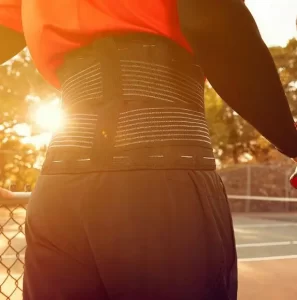Table of Contents
What Is Spinal Disc Pain?
Every day, thousands of Americans suffer from spinal disc problems. A spinal disc is a rubbery pad that connects your vertebrae, the specialized bones that make up your spine. These pads may swell in times of stress or injury, pushing through their tough outer membranes. It is possible for the entire disc to become distorted or bulge in some places. There are several disc-related problems, including scoliosis, degenerative disc disease, ruptured discs, sciatica, and bulging/herniated discs. Fortunately, much can be done to relieve your back or neck pain from a disc injury, including using a reliable back brace.

Common Spinal Disc Problems
Here are some of the most common conditions associated with spinal disc problems. Back pain should not be self-diagnosed. It can be helpful to understand what you’re experiencing, but only a medical professional can provide you with accurate treatment and therapy information.
- Scoliosis
An individual with scoliosis has a curvature of the spine to one side or the other. Throughout the last few decades, millions of children have been screened for this common back condition. Curves can be severe or mild, and their symptoms and risks differ depending on the cause. On X-rays and other imaging tests, scoliosis patients’ spines often have an S or C shape. Studies have shown that using a back brace can often prevent the progression of scoliosis and provide pain relief by supporting your spine.
- Degenerative Disc Disease
The natural aging process affects everyone differently. It is normal for spinal discs to show signs of wear and tear over time, but they shouldn’t cause you any pain. Discs in your spine absorb shock between your vertebrae (bones of your spine). Discs that have deteriorated and are causing pain are degenerative disc disease symptoms. They keep your body flexible even as you age by allowing it to bend and twist. However, spinal discs can become worn out as we age. They begin to break down and no longer function the way they used to.
- Herniated (Slipped Or Ruptured) Disc
Another very common spinal issue is herniated discs. In this condition, one of the rubbery cushions (discs) between the individual bones (vertebrae) in your spine malfunctions. The herniated disc occurs when softer “jelly” pushes out through a tear in the tougher exterior, sometimes also called a slipped disk or ruptured disc.
A herniated disc often causes nerve pain, weakness, and/or numbness in the arm or leg. Occasionally, a herniated disc will not cause symptoms. In most cases, surgery is not required to resolve the problem. The use of a back brace can provide stability and spinal support to help treat herniated disc pain.
- Sciatica
Sciatica occurs when an injury or strain puts pressure on the sciatic nerve. When the lumbar region of the spine is compressed, this nerve becomes irritated. Sciatica is often mistaken for general back pain; however, a range of specific symptoms set it apart from other spinal or nerve problems. Because the sciatic nerve is the longest in the body, it can cause pain in unexpected places.
- Bulging Discs
Bulging discs occur when the disc’s core presses against the disc’s outer ring, causing the disc to collapse and project into the spinal canal. A bulging disc is most often caused by age-related wear and tear on the spine. In addition, spinal discs can also be damaged by traumatic accidents such as car crashes or sports accidents. An injured disc puts increased pressure on the nerves inside and outside the spine, resulting in very strong responses.
Ways To Alleviate A Disc Injury
1. Rest
Resting the back can reduce inflammation and allow healing to occur. One or two days of bed rest may help relieve pain but should not be extended. A prolonged period of bed rest can stiffen the joints and weaken the muscles.
2. Avoid Painful Activities
It is important to avoid activities that increase pain levels. You can slowly resume activities if the pain begins to subside. It is recommended to avoid heavy lifting until the nerve root is no longer under pressure.
3. Low-Impact Physical Activity
Flexibility can be maintained by gentle stretching or light exercise that relieves pressure on the nerve root. If you aren’t sure which stretches and exercises will work for you, consult a physician or chiropractor in Naples Florida.
4. Use Temperature Therapy
Inflammation and pain can be relieved by alternately applying ice and heat therapy. A warm, wet towel or ice pack can be placed on the painful area. The first step should be to use cold packs to reduce pain and inflammation. One or two days later, heat therapy can relieve muscle tension.
5. Invest In A High-Quality Back Brace
A back brace can reduce the pressure on your spine by providing additional stability and support. Additionally, this support allows your back to heal after an injury. Besides providing additional support, a back brace helps reduce your range of motion. As a result, you are less likely to bend forward or twist your spine dangerously. Back braces help you become more aware of the position of your body by limiting your movements. By doing so, you can learn to lift heavy items and perform day-to-day activities more safely and comfortably.
6. Consider Over-The-Counter Medication
Nonsteroidal anti-inflammatory medications, such as ibuprofen and naproxen, can reduce inflammation and pain. The use of these medications should not extend beyond ten days without a physician’s approval. If these medications are taken longer than recommended, they can cause heart or bleeding problems.

